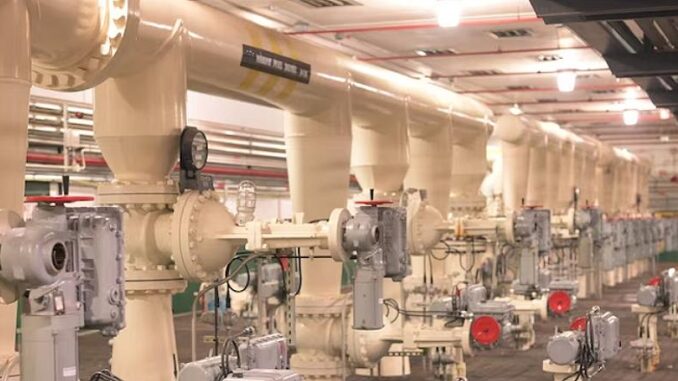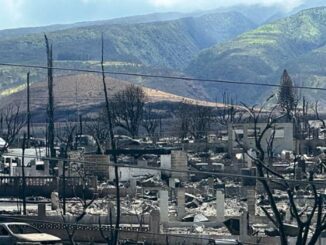
HONOLULU, Hawaii, October 11, 2023 (ENS) – Two years after the World War II-era Red Hill Bulk Fuel Storage Facility began leaking jet fuel into Honolulu’s drinking water, the U.S. Defense Department is ready to begin emptying millions of gallons of fuel from the defunct facility.
State officials signed off on defueling plans on Tuesday, and the U.S. Environmental Protection Agency gave the plans the green light last week. Defueling is set by begin on October 16.
U.S. Defense Secretary Lloyd Austin in March 2022 ordered the underground fuel storage facility permanently closed after jet fuel leaked from its tanks and contaminated nearby well water in late 2021.
That contaminated well was part of the U.S. Navy’s distribution system that supplied tap water to about 93,000 people living in military communities on and near Joint Base Pearl Harbor-Hickam in Honolulu. Thousands of residents were forced to relocate to area hotels for months.
Each of the 20 tanks at Red Hill measures 100 feet in diameter and is 250 feet in height. They are situated under a volcanic mountain ridge about 100 feet above an aquifer that supplies much of Honolulu’s tap water.
The jet fuel to be removed will drain by means of gravity through about three miles of pipes that end at a fueling pier on Joint Base Pearl Harbor-Hickam.
The fuel will be loaded onto tanker ships and relocated to several places: San Diego, California; Subic Bay in the Philippines; the Port of Singapore; and a pair of fuel depots in Hawaii, the task force said in a statement Tuesday, responding to a query by the Department of Defense newspaper “Stars and Stripes.”
The job will take about three months, according to Joint Task Force-Red Hill, the entity overseeing the operation, reports Wyatt Olson in “Stars and Stripes.” Filling a tanker takes about 52 hours, and the task force expects the removal to take nine movements.
The first transport ship, the merchant tanker Empire State, is scheduled to arrive at Pearl Harbor early Wednesday morning, the task force said.
The first phase of defueling will require two of the facility’s three main pipelines, bringing the fuel level in the tanks to about 10 feet. That remaining fuel will be drained using a connection newly built for the defueling process, the Health Department said in its letter of conditional approval.
Among the upgrades to the facility required by the Health Dept. were improvements to fire-suppression equipment and upgraded spill mitigation measures.
On October 10, the Hawaii Department of Health gave the Joint Task Force-Red Hill conditional approval to begin emptying 104 million gallons of fuel now in the tanks.
“Today’s conditional approval marks an important milestone in the process that will ultimately result in permanent closure of the Red Hill Facility and remediation of our aquifer,” Kathleen Ho, deputy director of environmental health for the Department of Health, said.
“Many people have worked for many months to reach this milestone, and we appreciate and fully expect that the Joint Task Force will continue to uphold its commitments to the people of Hawaii and our environment,” Ho said.
The approval is conditional on the Joint Task Force’s adherence to requirements placed on the operation by the Department of Health, which will have staff onsite to oversee the defueling.
The start of defueling next Monday comes after more than a year of planning, repairing and training by the Red Hill Joint Task Force. The state health department required 297 separate repairs and enhancements to the vast underground piping system to safely conduct the defueling.
“We commend the leadership of the Department of Health in this ongoing crisis, and we want the public to know that my administration will continue to insist on transparency and accountability as the defueling of the bulk storage facility progresses,” said Governor Josh Green, M.D.
“All of us in leadership positions – whether government, community organizations and, of course, the military – have to work together to ensure the water and the land at Red Hill and the aquifer under it, will be remediated properly and expeditiously. Clean water for future generations must be our shared goal,” the governor said.
“After months of methodical planning, preparing and rehearsing, we are ready to begin defueling Red Hill and setting the conditions for its closure,” Vice Adm. John Wade, the task force commander, said in a statement.
“We have taken significant precautions to mitigate risk for safe operations, ensure preparedness to respond to contingencies, and protect the aquifer, environment, and human health as we defuel the facility,” Vice Adm. Wade said.
The Navy has set up temporary air monitoring stations on Joint Base Pearl Harbor-Hickam and at adjacent military housing communities to monitor the defueling process, the “Honolulu Star-Advertiser” reports. The monitoring is “part of a greater spill response strategy to identify, quantify and assess potential threats to public safety, should there be a spill during the defueling of Red Hill,” a Navy spokesperson assured the newspaper’s readers.
Featured image: The Red Hill Underground Fuel Storage Facility pump room. This facility has supplied approximately 15-20 million gallons of fuel to the Rim of the Pacific (RIMPAC) exercise every two years. (Photo by Daniel Mayberry courtesy U.S. Navy)



